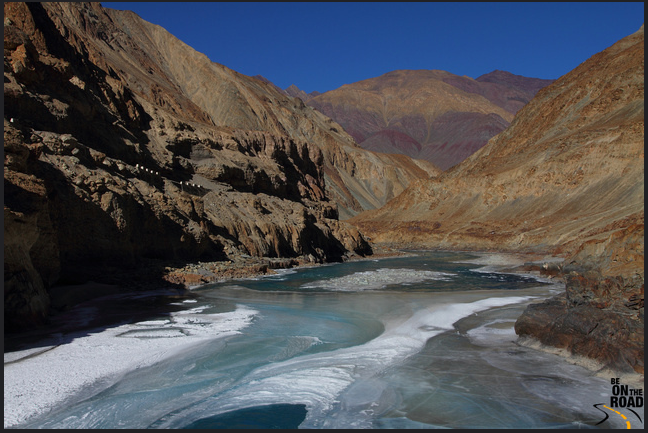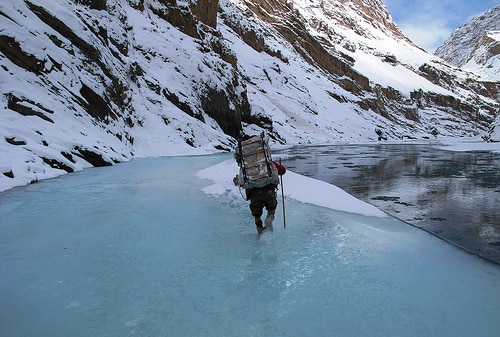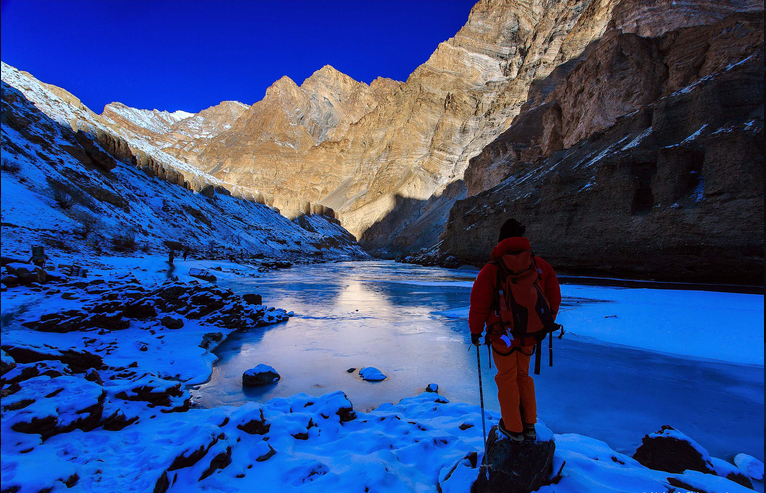India: Chadar Trek on the Zanskar Frozen River in Ladakh
The Frozen River Trek, Ladakh (India): An Icy Wilderness
The emerald green-turquoise Zanskar River flows through one of the most remote landscapes in the world, and a blanket of pristine white ice (Chadar) forms on the river to create a trail. All around are towering brown ice-capped mountains that sometimes close in on you and then open up suddenly to give you a glimpse of the azure sky. The Frozen River or ‘Chadar’ trek in Ladakh (India) throws up such dramatic vistas. Here ice melts, water freezes, and biting winds slice and carve away at the rock faces to continuously construct and deconstruct the landscape. Even the trail vanishes occasionally and reappears elsewhere. The Chadar you see today will not be the same tomorrow!
The Icy-White Chadar, the Turquoise Zanskar River, the Muddy-Brown Mountains, and the Azure Sky Source: The Frozen River Trail, Photo by Sankara Subramanian on Flickr
The Aura of the Frozen River Trek
The Frozen River trek in Ladakh is not only one of the most beautiful treks in the world but also has an almost magnetic pull for hikers.
The trek is across an ancient route that used to be a part of the Silk Road. Many centuries ago, traders from the Zanskar region traversed the Chadar to transport their wares to Leh. In present times, the Chadar is still the communication lifeline of the Zanskaris. In winter, the road to the remote Zanskar region across the high mountain passes is closed because of snow. So the people in this region take the Chadar trail to commute. So, what is one of the most adventurous treks in the world is actually all in a day’s work for the Zanskaris. On the Frozen River trail, you also have the opportunity to visit and stay in remote Ladakhi hamlets, interact with the locals, and experience from close quarters a way of life that has not changed in hundreds of years.
The sight of dramatic primal landscapes that are always in a flux, the thrill of finding your own way through the ever-shifting Chadar, and the opportunity to mingle with local Ladakhi people make the Frozen River trek a truly unique adventurous and cultural experience.
The Essentials of the Frozen River Trek
The Frozen River trek takes place during the months of January and February when a sheet of ice forms over the Zanskar River. However, the ice becomes stable enough for walking safely usually by the third week of January.
The trek starts from Chilling that is about three hours by road from Leh, the capital of Ladakh. The trail follows a circular route meaning that your trek starts and ends in Chilling. The trek is usually a nine-day affair but throw in a couple of days more if you want to visit and stay in the remote Lingshed village and explore this area.
Direct flights connect New Delhi to Leh, and travel agencies will usually arrange to pick you up from the airport, drop you off at your hotel, and then drive you to Chilling the next day. Expect to pay about $50 to $60 per person per day for the trek. However, this rate may go up to $80 per person per day if you choose to go in groups of less than four people or opt for a package where the trekker-to-porter ratio is 1:1. The packages include lodging in Leh; transportation to and from Chilling and Leh; campsite charges; guide, porter, and cook fees; and the cost of kitchen equipment, tents and mattresses, and food served during the trek. Some trek organizers may provide sleeping bags and include these charges within their packages.
The Frozen River trail has a gentle gradient, and the highest point is just a tad below 11,000 feet. If you can acclimatize to Leh, you won’t be bothered by the altitude at any point during the trek. However, the frigid temperatures might take some getting used to. The average day-time temperature is between 14oF and 23oF while it may drop to -13oF at night in some camps. But dress yourself in multiple layers of thin clothes and winter wear and carry a warm sleeping bag (if your trek organizer does not provide one), and you will stay cozy.
Wading Through Ankle-Deep Water on the Chadar Trek
Source: On the Frozen River Trail, Photo by Worth Travel
The entire trek is over snow and ice, so a pair of good hiking boots will suffice. Wear waterproof ones because you might have to wade through ankle-deep water at some points along the trail.
Although you don’t have to battle altitude on the Frozen River trek, be prepared to walk for long distances in intense cold. So it is essential that you are in good physical condition at the start of the trek.
On the Zanskar Frozen River Trail
Your trek starts at Chilling. The first few steps on the Chadar feel exhilarating, but don’t hurry. Get a feel of the surface first. The sheet of ice may be coated with a fresh coating of powdery snow, which is easy to walk on. But the Chadar may also be a hard icy and slippery surface; walk slowly keeping your feet on the ground as much as possible; you will waddle more than walk.

Source: Walking on Ice on the Chadar Trail, Photo by Partha Chowdhury on Flickr
The Chadar is also not consistently thick at all places on the trail. It is a thick continuous slab of ice in places where the mountains on either sides of the river close in on each other to form a canopy and block the sun from reaching the ground. In fact, some rocky ledges hang so low that you will have to crawl on all fours to move under them. At other places, the Chadar is parchment-thin and sometimes so translucent that you can see the swirling waters of the Zanskar River flowing underneath and fish darting away when your shadow looms over them. Enjoy the sight, but tread carefully and move away quickly. If the ice sheet is too thin, you will have to trudge up and across the snowy embankment or the rocky ledge on the side and then descend to the level of the river at a spot where the ice is hardier.
As you walk, crawl, and waddle on the Chadar, keep an eye out for pug marks of the snow leopard. You are in their territory, but you would be very lucky to spot one. These beasts are so elusive that they have attained an almost mythical stature. However, keep your zoom lenses ready because hordes of ibex frequent the slopes around the river.

Source: On the Frozen River Trail, Photo 3.bp.blogspot.com
You will be treated to the mesmerizing sight of frozen waterfalls at many places along the trail. But the most spectacular of these—a 50-feet ice fall—awaits you as you near the Nerak campsite, which you will reach approximately on the fifth day of your trek.
Camping by the Chadar
Source: Camping on the Frozen River Trek, Photo by Partha Chowdhury on Flickr
The Nerak campsite is on a higher ground. But during the trek, you will also camp by the Zanskar river and sometimes in caves along with local people who are making the trek to trade, take their children to schools, get to a medical facility in Leh, or returning home. These caves have been around for centuries and have housed trekkers and protected them from the elements since the days of the Silk Road. Look around, and you will see soot from fires that have burned through the ages and have blackened the walls and ceilings of the caves.
Many trek operators take you till Nerak and then return from there. But some agencies also have packages where you can trek further to Lingshed village, stay here for a few days, explore the region, get to know the “mountain people,” and observe age-old Buddhist cultural and spiritual traditions in practice.
The Magic of the Chadar
Source: On the Chadar Trail, Photo by Chittaranjan Desai
The Frozen River trek is more than just a trek; it is your once-in-a-lifetime opportunity to visit a land that is frozen in time. A road is right now being constructed between Chilling and Padum to keep the Zanskar region connected to Leh all throughout the year. The road will definitely ease the lives of the Zanskaris who will no longer have to trudge for days to reach Leh. But will the Frozen River trek be rendered obsolete? Not likely; the call of the wild will still stir the hearts of adventurers!
Did You Know?
Some trek operators provide bio-degradable bags made wholly of corn starch to trekkers. Trekkers use these bags to defecate, and these are then buried underground. These bags decompose within a month, and their use ensures that human waste does not pollute the fragile Ladakhi environment.
You’ll have to pass through the city of Leh, Ladakh before and after your Chadar Trek. If you’re looking to save money, the Rebook Center is a good cheap option. The Thongsal Hotel is a decent mid-range choice, while the Grand Himalaya Hotel offers a bit of luxury for tired trekkers.
If you’re not confident in organizing such a trip yourself, there are also plenty of tour companies that organize hiking trips or mountain biking excursions in the region.
Finally, thanks to Yasmin A. for the excellent guest post. If you’d like to contribute your own tales of hiking in Asia, please Contact Us to find out more.




Thanks for this useful article on chadar trek. The pictures are really mesmerizing. It’s in my bucket list to do with family and friends in 2020.
Good luck to you, Nazir!